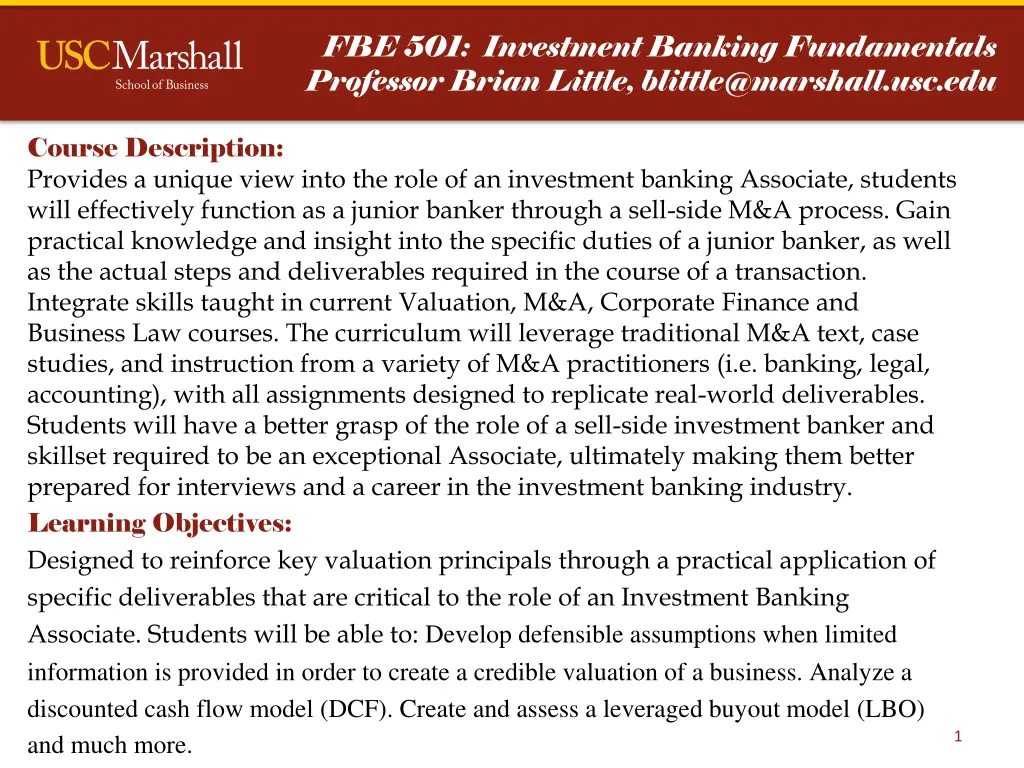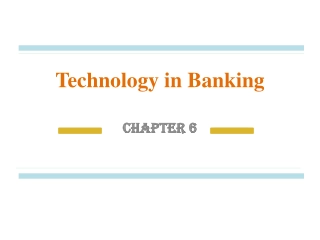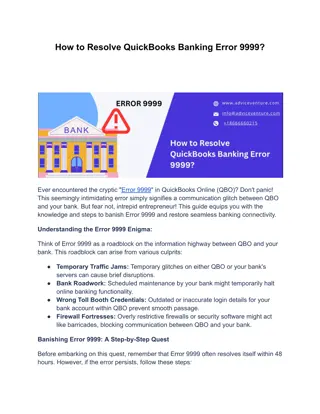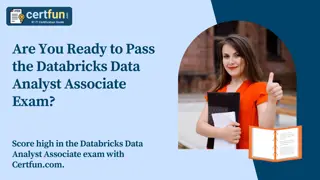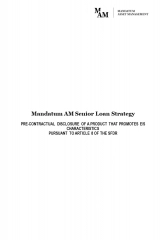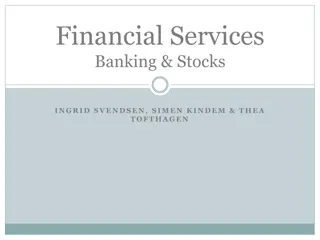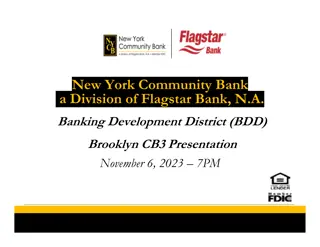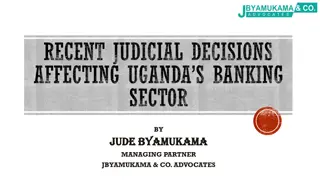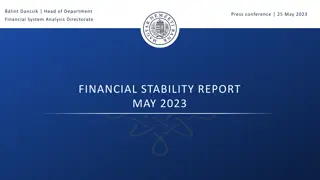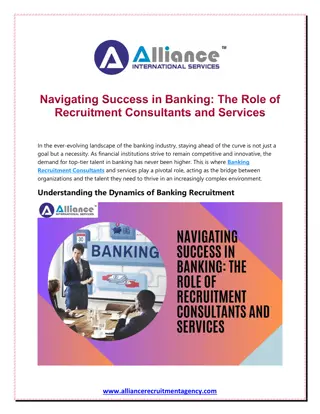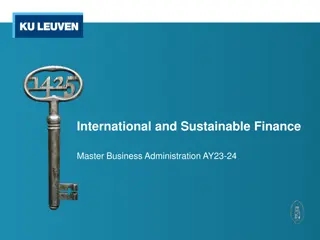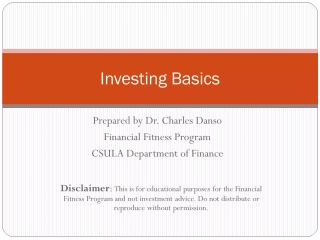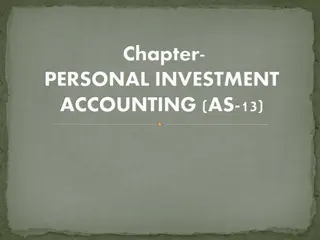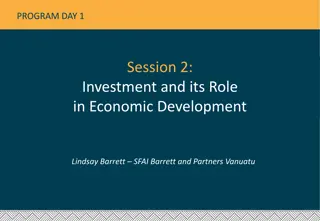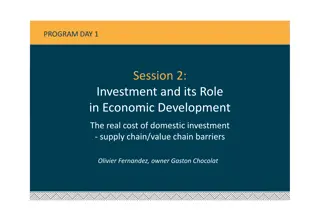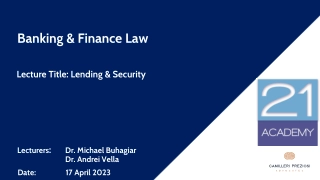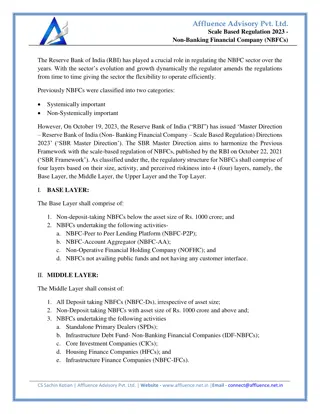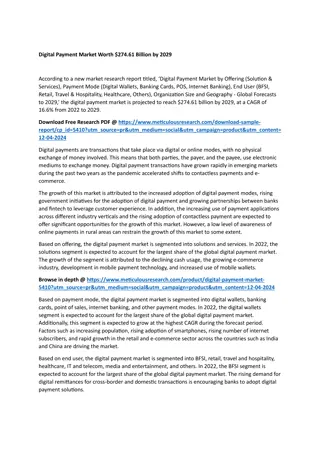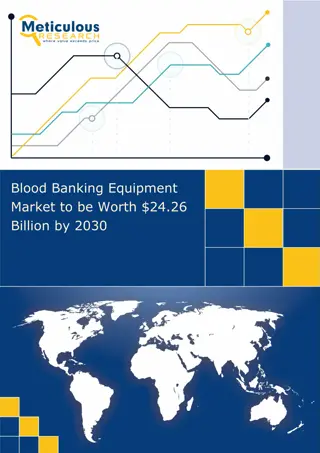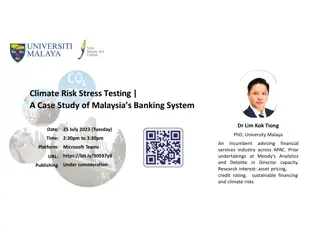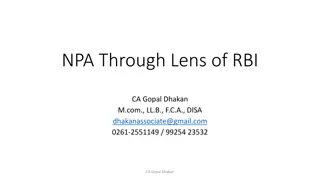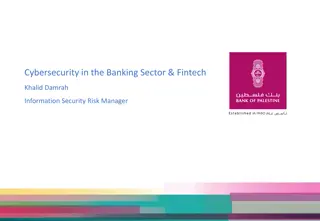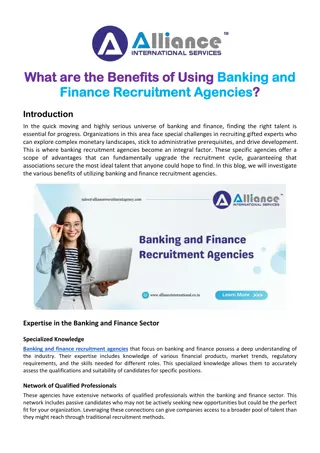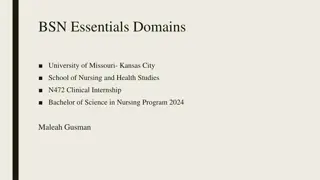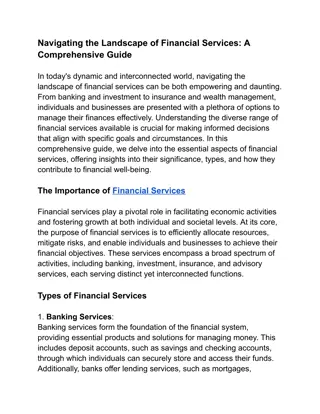Investment Banking Associate Essentials
Gain practical knowledge of investment banking Associate duties and sell-side M&A processes. Learn valuation, modeling, and finance skills essential for junior bankers. Enhance capabilities through real-world assignments.
Investment Banking Associate Essentials
PowerPoint presentation about 'Investment Banking Associate Essentials'. This presentation describes the topic on Gain practical knowledge of investment banking Associate duties and sell-side M&A processes. Learn valuation, modeling, and finance skills essential for junior bankers. Enhance capabilities through real-world assignments.. Download this presentation absolutely free.
Presentation Transcript
FBE 501: Investment Banking Fundamentals Professor Brian Little, blittle@marshall.usc.edu Course Description: Provides a unique view into the role of an investment banking Associate, students will effectively function as a junior banker through a sell-side M&A process. Gain practical knowledge and insight into the specific duties of a junior banker, as well as the actual steps and deliverables required in the course of a transaction. Integrate skills taught in current Valuation, M&A, Corporate Finance and Business Law courses. The curriculum will leverage traditional M&A text, case studies, and instruction from a variety of M&A practitioners (i.e. banking, legal, accounting), with all assignments designed to replicate real-world deliverables. Students will have a better grasp of the role of a sell-side investment banker and skillset required to be an exceptional Associate, ultimately making them better prepared for interviews and a career in the investment banking industry. Learning Objectives: Designed to reinforce key valuation principals through a practical application of specific deliverables that are critical to the role of an Investment Banking Associate. Students will be able to: Develop defensible assumptions when limited information is provided in order to create a credible valuation of a business. Analyze a discounted cash flow model (DCF). Create and assess a leveraged buyout model (LBO) and much more. 1
FBE 505: Behavioral Finance by Professor David Hirshleifer, hirshlei@marshall.usc.edu Course Description: Behavioral finance studies how the psychological biases of investors and managers affect financial decisions and markets. This course covers scientific evidence about what causes misvaluation, how investors can exploit market inefficiency in their trading decisions, how managers can address market mispricing in corporate financing and investment decisions, and how managers can correct for their own biases. To prepare students for practical financial decision making, the course has a quantitative component that includes factor models, portfolio theory, risk-adjusted discounting, and statistical data analysis, including regression methods. The course primarily involves lecture, discussion, in-class exercises, and student presentation, which will be applied to real-world examples and evidence. Course Objectives Through lecture, readings, and assignments, you will acquire the skills to: 1. Understand some key principles of psychology relevant for financial markets. 2. Understand some key aspects of how psychological processes affect the decisions of individual and institutional investors and other market participants. 3. Understand some key aspects of how psychological processes affect equilibrium prices and other market outcomes in financial markets. 4. Understand some key aspects of how psychological processes affect firm and managerial behavior. 5. Be able to apply these concepts to applied financial problems, including appropriate data analysis in support of well- considered decisions. 2
FBE 523: Venture Capital and Private Equity by Professor Steve Moyer, smoyer@marshall.usc.edu Course Description: Case study from investor (not entrepreneur) perspective. Covers basic valuation skills, credit analysis, VC & PE business model, VC & PE investment decisions process, LBO structures, exits, and distressed restructurings. Reviews important terms of VC term sheets and lending agreements. Excel and accounting skills sufficient to model, analyze and value business and investment. Learning Objectives: Understand the terminology, concepts and theories used in the investment process; Describe the diligence techniques and analytical tools employed to make investments; Analyze the terms and structures of the securities used in the investment process; Create Excel projection and valuation models; Collaborate in teams to analyze and present investment opportunities/problems. Course Workload/Process: Very demanding course with weekly deliverables. Significant involvement of guest speakers using Zoom sessions. 3
FBE 524Moneyand Capital Markets by Professor Fatemeh Nazarian at Ibrahimi@marshall.usc.edu Course Description: An overview of the global financial system, introducing the important institutional players, describing and classifying financial markets where institutions and individuals operate, and developing an analytical framework to understand the determinants of prices and yields at which financial transactions occur. Emphasizes understanding and evaluating the significance of financial market events, focusing on the financial crises that occurred in the summer of 2007 as well as the global economic recession outlook during the Covid-19 Pandemic Crisis. Provides an integrated analytical framework for understanding the effects of economic forces and economic policy on key financial market variables that determine the success of business strategies and present risks to firms or individuals from changes in interest rates, equity values, and exchange rates. Overarching Learning Outcomes: The first component covers the Financial markets: Money and Payment System, The Financial Markets (The Bond market, the Stock Market, Derivative markets (Forward,, Futures, Options, and Swaps), and the Market for Foreign Exchange). The second component covers Banking: Commercial Banks, Investment Banks, and Investment institutions (Mutual funds, Hedge Funds, and Finance companies). The Third component covers Federal Reserve, Monetary policy, and the financial system and the macroeconomy. Business Cycles: Recessions/Crisis--Financial crisis and Covid-19 crises. 4
FBE 527: Entrepreneurial Finance by Professor Duke Bristow, dbristow@marshall.usc.edu Course Description: Students will develop a semester-long financing plan for businesses that interest them ranging over the entire economic gambit. These range from the cutting edge of digital businesses, information technology, data mining, fin tech, gaming, to life sciences including biotech, pharmaceuticals, nutraceuticals, to more common food service restaurants, food products, to real estate, to Airbnb-type and Uber-type Gig businesses, to personal and professional services, to family businesses. Non-US based businesses are welcome. This is a good fit for MSF, DSO, Greif and MSSE students looking for a practical finance elective. In this class, you will meet others interested in entrepreneurship. Learning Objectives: 1. Develop a Financing Plan (PPM) for an ethical entrepreneurial enterprise in a global marketplace. Understand the key factors internal and external to the firm influencing the likelihood of a successful financing. 2. Build a Revenue Model and show how cash flow is connected to Revenue in a Cash Flow Model. Relate capital investment to growth. 3. Project Income Statements and Balance Sheets 5 years into the future. Determine pre- and post-money valuations of developmental firms. Learn to speak the language of finance and accounting. 4. Write a compelling and motivating funding document to build and sustain a high-performance dynamic team focused on excelling in a changing global business landscape 5
FBE 529: Financial Analysis & Valuation by Professor Suh-Pyng Ku - Suh-Pyng.Ku@marshall.usc.edu Course Description: This course is designed to help students to develop a theoretical valuation framework, apply valuation methods to various business settings, and gain an understanding of the underlying critical assumptions. Through the use of various case studies and examples, the course covers the practical application of valuation techniques using real-world data to make informed strategic and financial decisions, such as, mergers and acquisitions, private equity and venture investing, and the impact of financial leverage. Financial analysis and valuation in practice require a combination of theory and judgment, and this course will help you develop your skills in both areas. Learning Objectives: By the end of the course, students should be able to: 1. Analyze financial statements for performance evaluation and valuation 2. Understand the different valuation frameworks, their strengths and weaknesses, and their appropriate applications 3. Relate the impact of industry and market competitive forces to financial performance and valuation 4. Apply the valuation frameworks and techniques to publicly-traded and privately-held enterprises; and 5. Gain perspectives from seasoned investment professionals. 6
FBE 531: Corporate Financial Policy & Corporate Governance by Professor Kenneth Ahern, Kenneth.ahern@marshall.usc.edu Course Description: Advanced analysis of the determinants of corporate capital structure and payout policies, allocation and value of corporate control, and security issuance and retirement. The conceptual framework and applications developed in this course will be useful to students who seek to understand both the institutional details of, and substantive motivations for, important corporate financing decisions. In terms of career tracks, the skill set developed in this course will provide a strong foundation for analyzing corporate financial policies for (i) those people who will work for corporations, with or without a specialization in finance, (ii) those who will serve as outside consultants to corporations on appropriate financial policies, (iii) those who will work as external financial analysts, or more generally, for (iv) anyone interested in understanding the financial decisions made by corporate management. Learning Objectives: Students will be able to: Apply theories, models, and frameworks to analyze capital markets; Apply analytic tools to solve specific problems central to corporate finance; Develop abstract ideas to generalize solutions to corporate finance problems; Understand the ethical and professional standards in corporate financial decision- making, Work with colleagues to solve problems. 7
FBE 545: Applied Financial Modeling by Professor Mark Griffiths, markgrif@marshall.usc.edu Course Description: Analyze complicated financial situations and to present the analysis in a coherent and professional manner. The vehicle used for developing such models is the familiar spreadsheet Excel. Students will learn how to design specialized Excel tools and models to evaluate financial problems not covered by built-in Excel functions. Students will learn modern techniques to perform such tasks as: Incorporating dynamic changes in growth -related profitability estimates using pro forma cash flow scenarios. Forecasting desire /implied levels of debt under changing economic conditions. Evaluating the accuracy and sensitivity of common financial tools (such as the weighted average cost of capital for capital budgeting purposes) and the errors therein. Preparing financial forecasts to support various financing alternatives including the valuation of collateral (e.g., designing a bank s borrowing base for its clients). Evaluating the return to stakeholders in the event of insolvency and/or bankruptcy proceedings (e.g., analyzing the implications of the Absolute Priority Rule). Learning Objectives Improve financial decision-making ability in an uncertain business context and reduce the amount of time needed to apply this knowledge. Handle financial analysis in a more efficient and creative way leading to better appreciation by the target audience of what they are trying to achieve. Improve their communication skills through both quantitative and graphical presentations, and more. 8
FBE 551: Quantitative Investing Course Description: Modern investment management is increasingly quantitative in nature, and investment strategies are more and more determined by the output of data-driven models rather than the subjective views of analysts and portfolio managers. We will learn how to build, test, and implement the types of models in use today by quantitative asset managers. The course will have a substantial programming component, which will be carried out in Python. The course will not provide student with a general knowledge of Python, but rather only the components of Python necessary to do the buy-side quant research that will be our focus. These components are very different from those that a derivatives-focused course would use, and they are much more limited than those that a general programming course would cover. Learning Objectives Students will be able to: Describe the most common strategies used in quantitative investing; Propose, test, and implement novel quantitative investing strategies; Perform the statistical analysis and computer programming necessary for estimating models of security prices; Present their investment ideas and results in a way that is understandable to the layperson and to the finance professional and Articulate the research analyst role at quantitative buy-side firms. 9
FBE 555: Investment Analysis and Portfolio Management Course Description: Develop a framework from which to think about financial investment decisions. Financial investment refers to investment in financial assets, such as stocks, bonds, and derivatives. The course is taught from the perspective of an investor. Some of the topics include risk and return, investor utility, diversification, asset-pricing models, market efficiency, behavioral finance, and security valuation. We will focus on the practical application of these topics, although we will learn enough theory to understand why the practical applications make sense. Learning Objectives: Upon successful completion of this course, students will be able to: Measure the relation between risk and return; Perform optimal portfolio selection based on mean-variance analysis and asset-pricing models; Explain how stock, bond, future, and option prices are determined and how to make investment decisions based on economic theories and quantitative tools 10
FBE 558: Law of Structuring, Financing and Managing Businesses by Professor Kerry Fields, fields@marshall.usc.edu Course Description: Covers a variety of legal topics of greatest interest to those who wish to organize, finance, and manage business organizations. It covers the legal aspects of the life cycle of a business. We begin with a review of agency law, a subject that is important because organizations and their principals will be liable for the acts of their agents occurring within the scope of their employment. We proceed with business structures, including partnerships, both general and limited, limited liability companies, and special entities such as cooperatives, joint ventures and franchising. The law of human capital including wage and hour law and employment discrimination is discussed. Learning Objectives: Learn how agents create liability for you and the company; Identify the best business organization form for your enterprise (partnerships and limited liability companies (LLCs), franchising, joint ventures, and cooperatives, corporations and related governance issues); Apply the significant aspects of employment law in managing a workplace (federal and state); Learn the ins and outs of covenants not to compete (in most states they are enforceable against employees), wage and hour laws, personal liability for enterprise wage and hour violations, what happens when an employment discrimination claim is filed with the EEOC. Gain a working knowledge of mergers and acquisitions (reviewing actual prior deal documents) buying and selling businesses and much more. 11
FBE 559: Management of Financial Risk by Professor Jason Donaldson, jrdonald@marshall.usc.edu Course Description: This course intends to be an introduction to Financial derivatives, namely options, futures and swaps. Our main goal will be to focus on the uses of derivatives for hedging and speculation and to understand risk neutral pricing of derivatives. The emphasis of the course will be on conceptual issues as opposed to the institutional aspects (although the basic institutional aspects will be covered). By all standards this is a quantitative class and a good background in calculus and statistics is highly desirable, if not necessary. Knowledge of Excel will be useful (though not required) as some analysis will be done in Excel. Learning Objectives: An objective of the course will be to understand how to compute futures prices and options under various assumptions. Student should also gain knowledge in how to use futures and options to hedge and speculate on risks. Students will learn how to apply these ideas within a real options framework to identify valuing creating strategies within a firm. 12
FBE 591: Real Estate Finance and Investments by Professor Selale Tuzel, Tuzel@marshall.usc.edu Course Description: Graduate-level exposure to theory and analytical methods used for valuing and pricing mortgages, mortgage-backed securities, and derivatives. In doing so, this course provides insight into not just how mortgage-backed securities and real estate capital markets operate, but also why. It provides a broad overview of mortgage-backed security, in-depth discussion of specific structure finance products, and hands-on exercises to enhance learning of key concepts. The growth in the scale and complexity of the U. S. mortgage market since the securitization revolution of the 1980s has been enormous. The volume of outstanding mortgage related securities has grown to 9.8 trillion as of the second quarter of 2019, of which about $600 billion is in commercial mortgage backed securities. In comparison, the volume of outstanding marketable Treasury securities was about $16 trillion, total corporate debt securities was about $8 trillion. The Federal agency mortgage-backed securities outstanding has increased by more than 20 times over the last two decades, from about $348 billion in 1987 to over $7 trillion currently. Learning Objectives: The primary objective of this course is to combine the theory of finance with the practice of real estate capital markets to enable you to make intelligent business decisions in increasingly complex and turbulent real estate markets 13
FBE 591: Real Estate Finance and Investments by Professor Selale Tuzel, Tuzel@marshall.usc.edu Course Description: This course introduces students to the principle issues involved in real estate investments and finance. The course is rigorously built on the foundations of financial economics established in core finance classes (GSBA 548). We will cover topics such as property valuation, mortgages and mortgage-backed securities, and real estate investment trusts. The course is designed to provide a hands-on learning experience. In addition to in-class lectures, the course features several case studies, projects based on real data, and prominent guest speakers from the industry. Learning Objectives: To prepare students for careers with some involvement in real estate. The target audience is not limited to students who plan exclusive careers in real estate. Since real estate is an integral part of the broader capital markets, understanding how the real estate markets work is critical for any successful career in finance. Upon the completion of the course the participants should be able to: Evaluate basic real estate investments (prepare proforma statements, perform valuation) Evaluate financing choices for real estate investments Understand how the real estate markets are linked to the broader economy Learn about different real estate investment vehicles (direct ownership, ownership in REITs, .). 14
FBE 599: Advanced Decentralized Finance (DeFi) by Professor Vincenzo Quadrini, Vincenzo.quadrini@marshall.usc.edu Course Description: A brief description of the architecture underlying decentralized finance; the financial analysis to evaluate and assess the risk-return trade-off of cryptocurrencies and more generally of digital assets. The data analysis will be performed with Python. We will use Python because it is widely used in finance, and it is becoming more popular in the industry. We will present and discuss various applications, starting with the financial analysis of cryptocurrencies. Cryptocurrencies are just one component of DeFi. Many other applications are made operational with Smart Contracts. They include some of the most popular transactions in finance, including borrowing and lending. But the range of financial transactions that can be implemented through smart contracts is unlimited and potentially quite complex. Digital assets and Non-Fungible Tokens (NFT); how the tokenization of nontangible and nonfungible production can revolutionize the structure of certain industries. Learning Objectives: Understand how DeFi works and how it could revolutionize the market structure of finance; Identify the advantages and disadvantages of DeFi compared to traditional finance; Assess the role played by cryptocurrencies as mean of transaction and as store of value; Understand the difference between digital currencies and cryptocurrencies; Understand how smart contracts work and why they are important for finance; Assess the risk that the value of digital assets diverges from the fundamental value (price bubbles) 15
FBE 599: Media and Entertainment Finance by Professor Sanjay Sharma, sanjays3@marshall.usc.edu Course Description: Designed for graduate students considering initiating or advancing their careers in media and entertainment industry as investors, bankers, or executives in corporate/operating financial management. Cover applications of economic frameworks for evaluating investment and expected returns in the fast-evolving global dynamics of the entertainment industry across all platforms and outlets including film, television, streaming, music, book and magazine publishing, video games, performing arts, sports and advertising. Discuss, debate, and apply 25 real-life cases and address four principal considerations and applications (to be provided in the syllabus). Learning Objectives Explain and analyze the underlying dynamics that drive the business models and activities of medial and entertainment industry participants ranging from small producers to large conglomerates. Measure and manage feasibility and performance of capital investment across all media and entertain sectors. Analyze and select contracting frameworks for projects and investments at organization and individual creative and athletic talent and stars. 16
